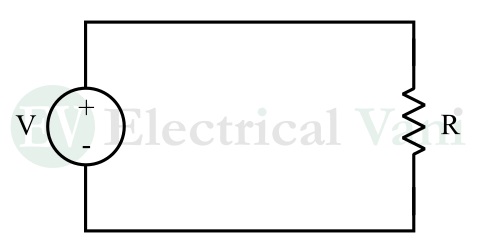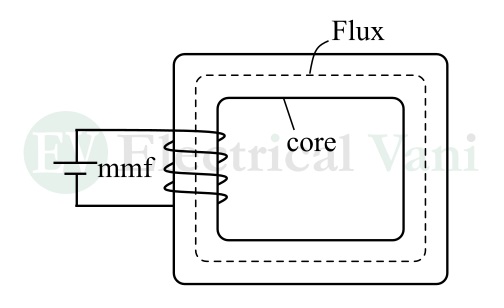This article will explain the important difference between electric circuit and magnetic circuit. The primary difference between an electric circuit and a magnetic circuit is that an electric circuit is a closed path followed by an electric current, while a magnetic circuit is a closed path followed by a magnetic flux. However, the electric and magnetic circuits are different from each other in many aspects that we will discuss in this article. But before that let us first know the basic theory of these two types of circuits individually.

What is an Electric Circuit?
An electric circuit is a network made of various electronic components like resistors, inductors, capacitors, batteries, lamps, etc., and provides a closed path for the flow of electric current.
The resistors, inductors, sources, etc. are known as circuit components. The primary function of an electric circuit is to perform a useful task by allowing the flow of electric current.
A typical electric circuit is shown in the following figure.

It consists of a voltage source, a resistor, and connecting wires.
Electric Circuit Quantities
The following are the basic electrical quantities associated with the electric circuits:
- Electric Charge – It is the most elementary electrical quantity, which can be defined as the subatomic property of particles due to which the substance exhibits electricity. Electric charge is denoted by “Q” and is measured in Coulombs (C). The charge can be of two types namely, positive charge (carried by protons) and negative charge (carried by electrons).
- Electric Current – The rate of flow of electric charge through a conductor in a certain direction is referred to as electric current. It is denoted by “I” and measured in Amperes (A). Electric current can be classified into two types namely, direct current (DC) and alternating current (AC).
- Voltage – It is also known as potential difference. Voltage is termed as the electrical pressure that pushes electrons in a circuit. It is defined as the energy required to move per unit charge from one point to another. It is denoted by “V” and measured in volts (V). Voltage can also be classified into two types namely, direct voltage and alternating voltage.
- Power – The rate of doing work in an electric circuit is defined as the electric power. It is denoted by “P” and measured in watts (W). Electric power can be classified into two types namely, DC power and AC power.
- Energy – Electrical energy is defined as the total amount of work done in an electric circuit over a certain period of time. It is denoted by “W” and measured in Joules (J) or Watt-second (Ws).
Types of Electric Circuits
There are two types of electric circuits given below:
- DC Circuit – An electric circuit followed by direct current is called a DC circuit. The main components of a DC circuit are resistors, sources of energy, and switches.
- AC Circuit – An electric circuit followed by alternating current is called an AC circuit. The main components of an AC circuit are resistors, inductors, capacitors, and sources of energy.
Applications of Electric Circuits
Electric circuits are used in a wide range of applications. Some key applications of electric circuits are listed below:
- Electric circuits are fundamental in various consumer electronic devices like smartphones, laptops, computers, TVs, etc.
- Electric circuits are used in lighting systems like residential lighting, street lighting, industrial lighting, automotive lighting, etc.
- Electric circuits provide a basic structure for power transmission and distribution.
There are several other fields exist that utilize electric circuits as their integral part.
What is a Magnetic Circuit?
A closed path followed by magnetic flux is called a magnetic circuit. Hence, in a magnetic circuit, the main quantity that flows in the circuit is the magnetic flux.
A magnetic circuit consists of some main components which are a source of magnetic flux and a magnetic core.

In practical magnetic circuits, the source of magnetic flux is an inductor coil and the core is a piece of highly permeable magnetic material.
Magnetic Circuit Quantities
The following are some basic quantities related to the magnetic circuits:
- Magnetic Flux – It is defined as the measure of magnetic field lines passing through per unit area at a right angle to the surface. It is denoted by “ϕ” and measured in Weber (Wb).
- Magnetomotive Force (MMF) – MMF is defined as the magnetic pressure that forces the magnetic flux in the magnetic core. It is equal to the product of a number of turns and current flowing in the coil. It is measured in Ampere-Turn (AT).
- Reluctance – The opposition or friction offered by the material of the core to the flow of magnetic flux is called reluctance. It is denoted by “S” and measured in AT per Wb.
Types of Magnetic Circuits
The following are two main types of magnetic circuits:
- Series Magnetic Circuit – A magnetic circuit that has only one path for magnetic flux to flow is called a series magnetic circuit.
- Parallel Magnetic Circuit – The number of paths for flux to flow is greater than one, the magnetic circuit is called a parallel magnetic circuit.
Applications of Magnetic Circuits
Magnetic circuits are important parts of various electromagnetic devices. Some of them are listed below:
- Transformers
- Induction motors
- Generators
- Relays
- Circuit breakers
- Electric bells, etc.
This is all about the fundamentals of electrical and magnetic circuits. Let us now compare these two types of circuits to understand their differences.
Difference between Electric Circuit and Magnetic Circuit
The major differences between electric and magnetic circuits are described in the following comparison table:
| Key |
Electric Circuit |
Magnetic Circuit |
| Basic | An electric circuit is a closed path or loop through which an electric current flows. | A magnetic circuit is a closed path through which a magnetic flux flows. |
| Main quantity | In an electric circuit, electric current is the primary quantity. | In the magnetic circuit, the magnetic flux is the main quantity. |
| Circuit components | In an electric circuit, the main circuit components are voltage or current sources, resistors, capacitors, and inductors. | In a magnetic circuit, the main components are a source of mmf and a magnetic core. |
| Driving force | In an electric circuit, EMF (electromotive force) is the main driving force. | In a magnetic circuit, the main driving force is the magnetomotive force or MMF. |
| Opposition | In an electric circuit, the resistance or impedance is the factor that opposes the flow of current. | In a magnetic circuit, the reluctance is the opposition to the flow of flux. |
| Density measure | In an electric circuit, the current density is relevant. | In the magnetic circuit, the flux density is relevant. |
| Unit of measurement | In an electric circuit, the electric current is measured in amperes. | In the magnetic circuit, the magnetic flux is measured in Weber. |
| Unit of opposition | In an electric circuit, the opposition to the flow of current is measured on Ohms. | In the magnetic circuit, the opposition to the flow of magnetic flux is measured in the AT per Wb. |
| Inverse of Opposition | In an electric circuit, the opposition is due to resistance, and its inverse is known as conductance. | In the magnetic circuit, the opposition is due to reluctance and its opposition is called permeance. |
| Insulators | There are various insulators such as mica, air, glass, wood, etc. used in electric circuits to prevent electric current leakage. | No perfect insulators exist to be used in magnetic circuits to prevent magnetic flux leakage. |
| Applications | Electric circuits are used in all devices that require electric current to operate. | Magnetic circuits are used in electromagnetic devices such as motors, generators, transformers, relays, bells, etc. |
Conclusion
In conclusion, an electric circuit is a closed path traced by an electric current while a magnetic circuit is a closed path traced by magnetic flux. Both circuits are widely used in various electrical and electromagnetic systems. In this detailed article on the “difference between electric circuit and magnetic circuit”, we have discussed the key differences between electric and magnetic circuits.